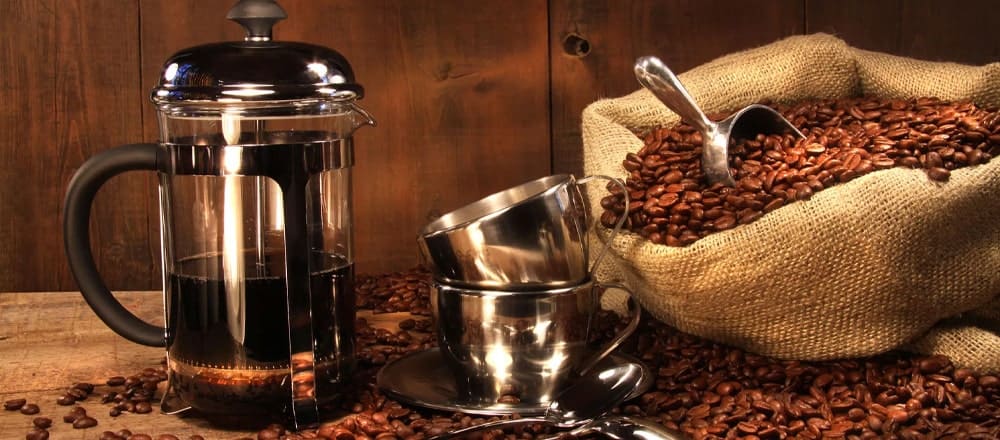How to Use a Cafetiere

A Coffee revolution is taking place. People are doing away with boring, bland instant Coffee and are instead making the “real deal.” If you, too, would like to achieve a quality-assured cuppa, you’re going to want to know how to use a cafetiere.
This item isn’t the only way to ensure your morning brew tastes good, but it is, undoubtedly, the most popular choice.
The following article will answer numerous questions such as “how to put together a cafetiere?”, “how to make cafetiere Coffee?” and “how to clean a cafetiere?”
It will also explore the basics of “what is cafetiere?” and “what are its origins?” You can then buy the ground beans right here at The Kent and Sussex Tea and Coffee Company. Shall we get started?
Table of contents

What is a Cafetiere?
A cafetiere (also called a cafetière, cafetière à piston, caffettiera a stantuffo, Coffee plunger, Coffee press or French press) is a brewing device. It consists of a heatproof jug, usually made of glass, with a strainer attached to its lid.
The way it functions is, broadly, by first brewing the Coffee and then plunging the strainer to the bottom to separate the grounds from the liquid. All that’s left, then, is to pour.
We will be talking more about how to use a cafetiere below. It is time now to explore its origins: the name, cafetiere, is a French noun for Coffee pot.
A tale associated with it, albeit an unfounded one, is that an old Frenchmen, frustrated by his nagging wife, escaped the house with a Coffee pot to hand. He found a fire to make a cup but promptly discovered that the grounds floating on the top ruined the experience.
The Frenchman improvised a plunger with some wire gauze to catch the loose Coffee, which seemed to do the trick. However, there is no evidence that such a story ever occurred.
What we do know is that Henri-Otto Mayer and Jacques-Victor Delforge filed the first patent for a similar device in 1852. Yet the first commercially successful utensil was created by another Frenchman, Louis Forest, in 1913.
Despite the term “French Press,” it was an Italian called Ugo Paolini who came up with a design most clearly a forebear of the modern-day cafetiere.
He later assigned his patent to Attilio Calimani and Giulio Moneta, who filed it in 1929. This particular device involved a filter to stop Coffee grounds from escaping. We continue to use such a method today – but how, exactly, does it work?

How to Make Cafetiere Coffee
You know the background behind “what is cafetiere Coffee?” and the basics of “how does a cafetiere work?” Let’s now look into how to use a cafetiere.
This section will show you the steps required to make a pot of Coffee using this ever-popular method. If you follow the stages closely, it won’t be long before you’re enjoying a cuppa in the comfort of your home.
1. Boil the Kettle.
Allow the water to cool slightly to avoid “burning” the grounds.
2. Weigh out the Coffee.
If you’re wondering, “do you use ground Coffee in a cafetiere,” the answer is yes. (The Kent and Sussex Tea and Coffee Company provide the option of having “Ground Cafetiere Coarse” for each of our Coffee types.) The rule of thumb is 1 tbsp per cup, which is about 7 grams.
3. Place the Coffee into the Cafetiere.
Add the ground Coffee beans to the base of the heatproof jug.
4. Pour the Water.
You’ll need to half-fill the cafetiere with hot water, pouring it over the grounds and then stirring it with a spoon. All of the Coffee should be wet and submerged. Once you’ve achieved this, you can add the rest of the water – 125ml per 1 tbsp of Coffee.
5. Add the Lid on Top and Allow it to Steep.
Don’t plunge it yet. This is where you want to be thinking about how long to brew cafetiere Coffee, the answer of which is four minutes. So set the timer.
6. It’s Time to use the Plunger.
Move the plunger down slowly and steadily, holding the handle with one hand and the plunger itself with the other. If you do so too fast, the grounds might escape the strainer, or the Coffee can spurt out of the spout, potentially scolding you.
7. Your Cafetiere Coffee is Ready.
Now that you know how to make perfect cafetiere Coffee, and indeed you’ve done so, you can treat yourself to a cup. Settle in and indulge.

How Much Ground Coffee in a Cafetiere?
The above step-by-step instructions offered a brief insight into how much Ground Coffee in a cafetiere per cup. A quick reminder: it should be around one tablespoon each, which is approximately seven grams.
But what if your friend or family member wants one, too? What if you have other guests for a dinner party, say, or even if you want more than one mug of Fresh Coffee? Here is an amount guide:
- Three cup / 350ml cafetiere = 3 tbsp or 20-23 grams.
- Four cup / 500ml cafetiere = 4 tbsp or 25-30 grams.
- Eight cup / 1 litre cafetiere = 8 tbsp or 50-60 grams.
Remember that some people, perhaps yourself included, prefer their Coffee strong. If you find yourself in this camp, and you’re wondering how much Coffee in a cafetiere you should put in, then simply put in more.
A heaped tablespoon might be enough to meet your personal tastes. It might, however, be a case of trial and error. The good news is that you’ll undoubtedly have fun experimenting!

How to Clean a Cafetiere
We have, so far, cleared up “how to make a cafetiere” – or, in other words, how to use a cafetiere. It is straightforward to put this device together and relatively straightforward to create a delicious, invigorating beverage from it.
But now we need to clear up, literally. This next section will show you how to clean a cafetiere ready for the next time you brew up.
The first thing you’ll want to do, of course, is finish your Fresh Coffee while letting the cafetiere cool. Once it has reached a manageable temperature to hold, you can empty the grounds before dumping them in the compost – not the sink!
It’s okay if a few grounds filter through your drain, but too many will clog it over time. Next come the soap and water for a quick, easy clean of the cafetiere itself.
Add a couple of drops of liquid dish soap to the jug along with some water, then replace the lid. Pull the plunger up and down until it becomes bubbly, at which point you can rinse and scrub inside.
Do the same to the lid using the soft part of your sponge or bottle brush. The water should run clean by the time you’ve finished. Ultimately, this cleaning method should suffice for the initial few times you use the cafetiere.
A deeper clean might require some disassembling. Instead of using liquid soap here, you should consider grabbing some baking soda and thoroughly scrubbing each piece of the cafetiere individually.
If you get hard water buildup, an alternative would be to make a 50/50 solution of vinegar and water. You should then apply this to both the interior and exterior of the device.

Buy Ground Cafetiere Coarse Coffee
There you have it: a clear-cut explanation to “how do you use a cafetiere.” You might, finally, be asking yourself, “What Coffee do I need for a cafetiere?”
The choice is yours when you buy from The Kent and Sussex Tea and Coffee Company. We stock over 70 types of Coffee, all of which we can grind to Ground Cafetiere Coarse specifications for the best possible results.
From Pure Arabica Coffee to Ethiopian Sidamo; Fair Trade Coffee Blend to Jamaican Blue Mountain, the possibilities are near endless. There is, indeed, little to worry about when it comes to “what Coffee do you use in a cafetiere?.
It’s entirely dependent on what taste, profile and characteristics you want your new favourite cuppa to have.
Best of all, we roast each one using the latest state-of-the-art Neuhaus Neotec fluidised air-bed system, which primarily uses convection heat transference to roast the beans.
We then pack them all fresh to order here at our Kent-based factory, ensuring not only quality but also consistency. Why not start your journey today? You won’t be disappointed!

 Loose Leaf Tea
Loose Leaf Tea Pyramids
Pyramids Tea Bags
Tea Bags Africa
Africa Assam
Assam Ceylon
Ceylon Chinese
Chinese Darjeeling
Darjeeling European
European Indian
Indian Japan
Japan Nepal
Nepal South East Asia
South East Asia Ayurveda Tea
Ayurveda Tea Black Tea
Black Tea Chai Tea
Chai Tea Flowering Tea
Flowering Tea Fruit Tisanes
Fruit Tisanes Green Tea
Green Tea Herbal Tea
Herbal Tea Matcha Tea
Matcha Tea Oolong Tea
Oolong Tea Organic Tea
Organic Tea Pu erh Tea
Pu erh Tea Rooibos Tea
Rooibos Tea White Tea
White Tea Asian Coffee
Asian Coffee Caribbean Coffee
Caribbean Coffee Central American Coffee
Central American Coffee South American Coffee
South American Coffee Coffee Blends
Coffee Blends Decaffeinated Coffee
Decaffeinated Coffee Espresso Coffee
Espresso Coffee Ethically Sourced Coffee
Ethically Sourced Coffee Flavoured Coffee
Flavoured Coffee Organic Coffee
Organic Coffee Single Origin Coffee
Single Origin Coffee Chocolate 1
Chocolate 1 Chocolate 2
Chocolate 2 Chocolate 3
Chocolate 3 Chocolate 4
Chocolate 4 Chocolate 5
Chocolate 5 Chocolate 6
Chocolate 6 Chocolate 7
Chocolate 7 Chocolate 8
Chocolate 8 Chocolate 9
Chocolate 9 Loose Tea Filters
Loose Tea Filters Tea Accessories
Tea Accessories Tea Bricks
Tea Bricks Tea Caddies
Tea Caddies Tea Caddy Spoons
Tea Caddy Spoons Tea Gift Ideas
Tea Gift Ideas Tea Infusers
Tea Infusers Tea Strainers
Tea Strainers